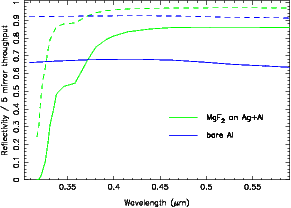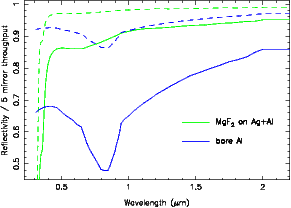DATABASE OF TECHNICAL DATA
TELESCOPE
A full description of the telescope's Baseline Reference Design can be found in this Messenger article and its update.
Photon collecting area
| The diameter of the telescope's primary mirror is | D = 42 m. |
| The diameter of the central obstruction is | d = 0.28 × D = 11.76 m. |
| The photon collecting area is | A = π/4 (D2 - d2) = 0.92 × π/4 D2 = 1276.82 m2. |
The segmentation of the primary mirror and any obscuring support structures are ignored.
Throughput
The telescope is a 5-mirror design (i.e. 5 mirrors to the Nasmyth foci). The total throughput of the telescope (τ = ratio of the number of photons arriving at the Nasmyth foci to the number of photons impinging on the primary mirror) is hence the product of the reflectivities, R, of each of the 5 mirrors. It is assumed that all mirrors have the same reflectivity. Hence we have
The reflectivity of a mirror is a function of wavelength and is determined by its coating. We consider two different coatings which have very dissimilar characteristics: the 'standard' bare aluminium coating and a more novel protected combination of silver and aluminium. The figures below show their reflectivities and total throughputs.
 |
 |
| Fig. 1 | Fig. 2 |
The protected silver/aluminium coating is clearly superior to the bare aluminium coating at all wavelengths > 370 nm. In particular, aluminium shows the well-known dip near 800 nm, and the protected silver/aluminium coating retains a significant advantage all the way into the mid-IR (see below). However, only aluminium provides access to the UV down to the atmospheric cut-off.
Data files containing the reflectivities and total throughputs.
These data were taken from the public TMT construction proposal. More information can be found in, e.g., Boccas (2004) who describes the first deployment of a protected silver coating at a large telescope (also summarised at this Gemini page). The plots shown in this talk from LLNL seem to suggest that there exist coatings (on Keck?) that have reflectivity > 90 % for all wavelengths > 300 nm…
Thermal emission
Each mirror is assumed to radiate like a grey body, i.e. its emission is given by ε bb(T), where bb is a black body's emission, and ε and T are the mirror's emissivity and temperature, respectively. The temperature is assumed to be equal to that of the site. The emissivity of each mirror is given by ε = 1 - R, where R is the mirror's reflectivity at mid-IR wavelengths: ε = 0.03 for the bare aluminium coating and ε = 0.01 for the protected Ag/Al. Since all mirrors have the same temperature the total emission from the telescope as seen by an instrument at the Nasmyth focus can be modeled as a single grey body with emissivity:
Hence we obtain εtot = 0.14 for the bare aluminium coating and εtot = 0.049 for the protected Ag/Al coating.
Note that εtot is not simply equal to 5ε. The additional factor is due to the attenuation of a given mirror's radiation by the imperfect reflectivity of subsequent mirrors. For example, since the radiation emitted by the primary mirror has to be (imperfectly) reflected by the 4 subsequent mirrors in order to reach the focus, only a fraction R4 actually makes it there.
E-ELT Science
What's New?
- 05 Dec 2014
Spending on first construction phase approved
Science Case
Project Science Team
Phase B (2006 – 2011)
- Science Working Group
- Design Reference Mission
- Design Reference Science Plan
- Tools: Imaging ETC / Spectroscopic ETC / Other software
